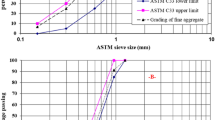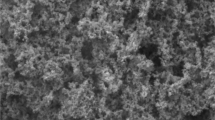Abstract
Incorporating nanomaterials into geopolymer composites enhances their performance by improving microstructural properties through the formation of additional C–S–H, N–A–S–H, and C–A–S–H gels and effectively filling nanopores within the matrix. This study focuses on an innovative approach to overcome challenges associated with nanoparticle (NP) production, through the environmentally friendly synthesis of nano-silica (NS) derived from olivine rock, specifically designed for construction applications. The results revealed that amorphous NS ranging from 7.9 to 43.4 nm could be successfully produced from olivine rock. Furthermore, incorporating 2% of this NS into geopolymer concrete mixtures resulted in a notable improvement in compressive strength, with enhancements of 13.09 and 13.07% at 28 and 90 days, respectively. The findings highlight the potential of olivine rock-based NS production, which could significantly impact the construction sector by enabling the affordable integration of NPs. Consequently, this advancement has the potential to increase the use of NPs in construction, leading to enhanced durability and strength in various construction materials.







Similar content being viewed by others
Availability of data and materials
All data generated or analyzed during this study are included in this published article.
Abbreviations
- GPC:
-
Geopolymer concrete
- NS:
-
Nano-silica
- NS-C:
-
Commercial nano-silica
- NS-LM:
-
Locally manufactured nano-silica
- NP:
-
Nanoparticles
- GGBFS:
-
Ground-granulated blast furnace slag
- C–S–H:
-
Calcium–silicate–hydrate
- N–A–S–H:
-
Sodium–alumino–silicate–hydrate
- C–A–S–H:
-
Calcium–alumino–silicate–hydrate
- SF:
-
Silica-fume
- NaOH and SH:
-
Sodium hydroxide
- Na2SiO3 and SS:
-
Sodium silicate
- FA:
-
Fine aggregate
- CA:
-
Coarse aggregate
- XRD:
-
X-ray diffraction
- SEM:
-
Scanning electron microscope
- M:
-
Molarity
- EW:
-
Extra water
- SP:
-
Superplasticizer
References
Das S, Mukherjee A, Sengupta G, Singh VK (2020) Overview of nanomaterials synthesis methods, characterization techniques and effect on seed germination. Nano-materials as photocatalysts for degradation of environmental pollutants. Elseiver, pp 371–401
Sharif HH, Ahmed HU, Faraj RH, Mawlod AO (2021) Fresh and mechanical characteristics of eco-efficient geopolymer concrete incorporating nano-silica: an overview. Kurdistan J Appl Res 2021:64–74. https://doi.org/10.24017/science.2021.2.6
Saleh TA, Gupta VK (2016) Chapter 4—synthesis, classification, and properties of nanomaterials. In: Saleh TA, Gupta VK (eds) Nanomaterial and polymer membranes. Elseiver, pp 83–133
Faraj RH, Mohammed AA, Mohammed A, Omer KM, Ahmed HU (2021) Systematic multiscale models to predict the compressive strength of self-compacting concretes modified with nanosilica at different curing ages. Eng Comput 2021:1–24. https://doi.org/10.1007/s00366-021-01385-9
Faraj RH, Ahmed HU, Rafiq S, Sor NH, Ibrahim DF, Qaidi SM (2022) Performance of self-compacting mortars modified with nanoparticles: a systematic review and modeling. Clean Mater 2022:100086. https://doi.org/10.1016/j.clema.2022.100086
Shojaei TR, Salleh MAM, Tabatabaei M, Mobli H, Aghbashlo M, Rashid SA, Tan T (2019) Applications of nanotechnology and carbon nanoparticles in agriculture. Synthesis, technology and applications of carbon nanomaterials. Elsevier, pp 247–277
Stark WJ, Stoessel PR, Wohlleben W, Hafner AJCSR (2015) Industrial applications of nanoparticles. Chem Soc Rev 44(16):5793–5805. https://doi.org/10.1039/C4CS00362D
Pitkethy MJ (2003) Nanoparticles as building blocks? Mater Today 6(12):36–42
Dubey RS, Rajesh YBRD, More MA (2015) Synthesis and characterization of SiO2 nanoparticles via sol-gel method for industrial applications. Mater Today Proc 2(4–5):3575–3579. https://doi.org/10.1016/j.matpr.2015.07.098
Niksefat N, Jahanshahi M, Rahimpour A (2014) The effect of SiO2 nanoparticles on morphology and performance of thin film composite membranes for forward osmosis application. Desalination 343:140–146. https://doi.org/10.1016/j.desal.2014.03.031
Dyshlyuk L, Babich O, Ivanova S, Vasilchenco N, Atuchin V, Korolkov I, Prosekov A (2020) Antimicrobial potential of ZnO, TiO2 and SiO2 nanoparticles in protecting building materials from biodegradation. Int Biodeterior Biodegrad 146:104821. https://doi.org/10.1016/j.ibiod.2019.104821
Lieftink DJ (1997) The preparation and characterization of silica from acid treatment of olivine. Universiteit Utrecht
Lazaro A, Brouwers HJH, Quercia G, Geus JW (2012) The properties of amorphous nano-silica synthesized by the dissolution of olivine. Chem Eng J 211–212:112–121. https://doi.org/10.1016/j.cej.2012.09.042
Ahmed HU, Mohammed AS, Mohammed AA (2022) Proposing several model techniques including ANN and M5P-tree to predict the compressive strength of geopolymer concretes incorporated with nano-silica. Environ Sci Pollut Res 2022:1–25. https://doi.org/10.1007/s11356-022-20863-1
Tahwia AM, Abd Ellatief M, Bassioni G, Heniegal AM, Abd Elrahman M (2023) Influence of high temperature exposure on compressive strength and microstructure of ultra-high performance geopolymer concrete with waste glass and ceramic. J Mark Res 23:5681–5697. https://doi.org/10.1016/j.jmrt.2023.02.177
Abdellatief M, Alanazi H, Radwan MK, Tahwia AM (2022) Multiscale characterization at early ages of ultra-high performance geopolymer concrete. Polymers 14(24):5504. https://doi.org/10.3390/polym14245504
Abdellatief M, Abd Elrahman M, Elgendy G, Bassioni G, Tahwia AM (2023) Response surface methodology-based modelling and optimization of sustainable UHPC containing ultrafine fly ash and metakaolin. Constr Build Mater 388:131696. https://doi.org/10.1016/j.conbuildmat.2023.131696
Ahmed HU, Mohammed AA, Mohammed A (2022) Soft computing models to predict the compressive strength of GGBS/FA-geopolymer concrete. PLoS One 17(5):e0265846. https://doi.org/10.1371/journal.pone.0265846
Tahwia AM, Abd Ellatief M, Heneigel AM, Abd Elrahman M (2022) Characteristics of eco-friendly ultra-high-performance geopolymer concrete incorporating waste materials. Ceram Int 48(14):19662–19674. https://doi.org/10.1016/j.ceramint.2022.03.103
Ahmed HU, Mohammed AA, Mohammed AS (2023) Effectiveness of nano-SiO2 on the mechanical, durability, and microstructural behavior of geopolymer concrete at different curing ages. Arch Civ Mech Eng 23(2):1–28. https://doi.org/10.1007/s43452-023-00668-w
Ahmed HU, Mohammed AA, Mohammed AS (2023) Effectiveness of silicon dioxide nanoparticles (nano SiO2) on the internal structures, electrical conductivity, and elevated temperature behaviors of geopolymer concrete composites. J. Inorg. Organomet Polym Mater 2023:1–21. https://doi.org/10.1007/s10904-023-02672-2
Ahmed HU, Mohammed AS, Mohammed AA (2023) Engineering properties of geopolymer concrete composites incorporated recycled plastic aggregates modified with nano-silica. J Build Eng 2023:106942. https://doi.org/10.1016/j.jobe.2023.106942
Amin M, Attia MM, Agwa IS, Elsakhawy Y, Abu El-hassan K, Abdelsalam BA (2022) Effects of sugarcane bagasse ash and nano eggshell powder on high-strength concrete properties. Case Stud Constr Mater 17:e01528. https://doi.org/10.1016/j.cscm.2022.e01528
Amin M, Zeyad AM, Tayeh BA, Agwa IS (2021) Effects of nano cotton stalk and palm leaf ashes on ultrahigh-performance concrete properties incorporating recycled concrete aggregates. Constr Build Mater 302:124196. https://doi.org/10.1016/j.conbuildmat.2021.124196
Hakeem IY, Alharthai M, Amin M, Zeyad AM, Tayeh BA, Agwa IS (2023) Properties of sustainable high-strength concrete containing large quantities of industrial wastes, nanosilica and recycled aggregates. J Mark Res. https://doi.org/10.1016/j.jmrt.2023.05.050
Hakeem IY, Amin M, Abdelsalam BA, Tayeh BA, Althoey F, Agwa IS (2022) Effects of nano-silica and micro-steel fiber on the engineering properties of ultra-high performance concrete. Struct Eng Mech 82(3):295–312
Ahmed HU, Mohammed AS, Faraj RH, Qaidi SM, Mohammed AA (2022) Compressive strength of geopolymer concrete modified with nano-silica: experimental and modeling investigations. Case Stud Constr Mater 2022:e01036. https://doi.org/10.1016/j.cscm.2022.e01036
Hakeem IY, Amin M, Zeyad AM, Tayeh BA, Maglad AM, Agwa IS (2022) Effects of nano sized sesame stalk and rice straw ashes on high-strength concrete properties. J Clean Prod 370:133542. https://doi.org/10.1016/j.jclepro.2022.133542
Ghanim AAJ, Amin M, Zeyad AM, Tayeh BA, Agwa IS (2023) Effect of modified nano-titanium and fly ash on ultra-high-performance concrete properties. Struct Concr. https://doi.org/10.1002/suco.202300053
Mardiana O (2017) Production and application of olivine nano-silica in concrete. IOP Conf Ser Mater Sci Eng 204:012008. https://doi.org/10.1088/1757-899X/204/1/012008
Reddy MS, Dinakar P, Rao BH (2018) Mix design development of fly ash and ground granulated blast furnace slag based geopolymer concrete. J Build Eng 20:712–722
Yu LY, Huang ZX, Shi MX (2014) Synthesis and characterization of silica by sol-gel method. Adv Mater Res 1030:189–192
Rahimzadeh CY, Barzinjy AA, Mohammed AS, Hamad SM (2022) Green synthesis of SiO2 nanoparticles from Rhus coriaria L. extract: comparison with chemically synthesized SiO2 nanoparticles. PLoS One 17(8):e0268184. https://doi.org/10.1371/journal.pone.0268184
Holzwarth U, Gibson N (2011) The Scherrer equation versus the’Debye-Scherrer equation’. Nat Nanotechnol 6(9):534–534. https://doi.org/10.1038/nnano.2011.145
Piro NS, Hamad SM, Mohammed AS, Barzinjy AA (2022) Green synthesis magnetite (Fe3O4) nanoparticles from rhus coriaria extract: a characteristic comparison with a conventional chemical method. IEEE Trans Nanobiosci. https://doi.org/10.1109/TNB.2022.3187344
Ahmed HU, Mohammed AA, Mohammad AS (2022) The role of nanomaterials in geopolymer concrete composites: a state-of-the-art review. J Build Eng 2022:104062. https://doi.org/10.1016/j.jobe.2022.104062
Gour A, Jain NK (2019) Advances in green synthesis of nanoparticles. Artif Cells Nanomed Biotechnol 47(1):844–851. https://doi.org/10.1080/21691401.2019.1577878
Ahmed HU, Faraj RH, Hilal N, Mohammed AA, Sherwani AFH (2021) Use of recycled fibers in concrete composites: a systematic comprehensive review. Compos Part B Eng 2021:108769. https://doi.org/10.1016/j.compositesb.2021.108769
Ibrahim M, Johari MAM, Maslehuddin M, Rahman MK (2018) Influence of nano-SiO2 on the strength and microstructure of natural pozzolan based alkali activated concrete. Constr Build Mater 173:573–585. https://doi.org/10.1016/j.conbuildmat.2018.04.051
Behfarnia K, Rostami M (2017) Effects of micro and nanoparticles of SiO2 on the permeability of alkali activated slag concrete. Constr Build Mater 131:205–213. https://doi.org/10.1016/j.conbuildmat.2016.11.070
Durak U, Karahan O, Uzal B, İlkentapar S, Atiş CD (2021) Influence of nano SiO2 and nano CaCO3 particles on strength, workability, and microstructural properties of fly ash-based geopolymer. Struct Concr 22:E352–E367. https://doi.org/10.1002/suco.201900479
Saini G, Vattipalli U (2020) Assessing properties of alkali activated GGBS based self-compacting geopolymer concrete using nano-silica. Case Stud Constr Mater 12:e00352. https://doi.org/10.1016/j.cscm.2020.e00352
Sun K, Peng X, Wang S, Zeng L, Ran P, Ji G (2020) Effect of nano-SiO2 on the efflorescence of an alkali-activated metakaolin mortar. Constr Build Mater 253:118952. https://doi.org/10.1016/j.conbuildmat.2020.118952
Alzeebaree R (2022) Bond strength and fracture toughness of alkali activated self-compacting concrete incorporating metakaolin or nanosilica. Sustainability 14(11):6798. https://doi.org/10.3390/su14116798
Mohammedameen A (2022) Performance of alkali-activated self-compacting concrete with incorporation of nanosilica and metakaolin. Sustainability 14(11):6572. https://doi.org/10.3390/su14116572
Funding
Not applicable.
Author information
Authors and Affiliations
Corresponding author
Ethics declarations
Conflict of interest
We wish to confirm that there are no known conflicts of interest associated with this publication, and there has been no significant financial support for this work that could have influenced its outcome.
Ethical approval
This article does not contain any studies with human participants or animals performed by any of the authors.
Informed consent
For this type of study formal consent is not required.
Rights and permissions
Springer Nature or its licensor (e.g. a society or other partner) holds exclusive rights to this article under a publishing agreement with the author(s) or other rightsholder(s); author self-archiving of the accepted manuscript version of this article is solely governed by the terms of such publishing agreement and applicable law.
About this article
Cite this article
Ahmed, H.U., Faraj, R.H., Hassan, A.Q. et al. Green synthesis of nano-silica from olivine rock and its impact on the mechanical performance of geopolymer concrete composites. Innov. Infrastruct. Solut. 8, 202 (2023). https://doi.org/10.1007/s41062-023-01171-0
Received:
Accepted:
Published:
DOI: https://doi.org/10.1007/s41062-023-01171-0




